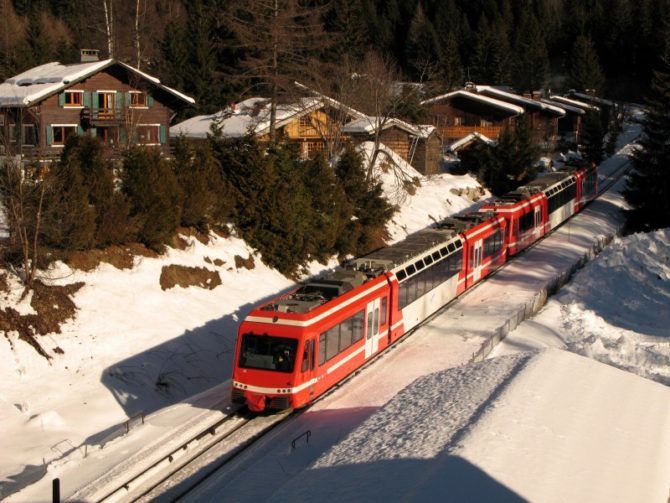The Mont Blanc Express

For some hardy souls the only way to enjoy the Alps is to buckle on the crampons, grab the climbing rope and clamber upwards—apparently the north face of the Eiger is absolutely guaranteed to provide thrills and spills. But for those of us who prefer to return from vacation in one piece, the best way to enjoy the Alpine experience is the Mont Blanc Express. One hundred and four years old this year, the 23-mile narrow-gauge mountain railway linking St-Gervais-les-Bains in France’s Haute Savoie with Vallorcine in Switzerland via Chamonix was the first of its kind in the world. Work on the line started in 1899, and gradually it pushed out from Saint-Gervais towards Chamonix, 12 miles away. That section was completed in 1901 and proved such a success—visitors to Chamonix multiplied sevenfold in two years—that it was decided to continue up the valley.
By July 1906, despite damage caused by a massive earthquake in 1905, the line had reached Argentière. Meanwhile, across the border, the Swiss were building their own line from Martigny to Châtelard, and it was agreed that the two Alpine lines should be linked. A 1.2-mile tunnel was dug through the Col des Montets, at a height of 14,547 feet. Problems with underground water that claimed the lives of eight workers added two years to the construction schedule, but eventually some 189 aqueducts and two viaducts over 130 feet high were built—a feat of engineering that would not be rivaled in France until the construction of the Millau viaduct over the Tarn River, completed in 2004. By the summer of 1908 the Mont Blanc Express was ready to roll, using a revolutionary new source of power: electricity. With local hydroelectric power abundantly available in the Arve valley, it was decided to abandon steam and employ newfangled electric motors. With the added power of electricity, the Mont Blanc Express could handle steep slopes—up to 9 percent—without resorting to rack and pinion.
Once in operation, it literally became the locomotive of tourism in the Alps. In 1890 when plans for the line were first mooted, Chamonix was a sleepy little village at the base of the Mont Blanc massif. But by the end of 1908 over 160,000 passengers had already clambered aboard the Express, launching a new era that established Chamonix’s reputation as a top Alpine resort; in 1924 it hosted the first International Winter Sports Week, which was retrospectively designated by the International Olympic Committee as the very first Winter Olympics.
Note: Starting in spring 2012 the line is being renovated on the French side and service will be partially or completely interrupted until 2014.
Originally published in the January 2009 issue of France Today; updated in November 2012
Share to: Facebook Twitter LinkedIn Email



